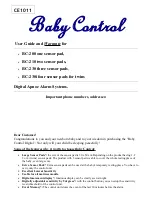
6.1 Instructions for Continued Airworthiness (ICA):
Maintenance and calibration
Maintenance and calibration
Maintenance and calibration
Maintenance and calibration
Maintenance and calibration - are “on condition” only. There are no field adjustments or calibration
requirements for the MVP-50P instrument after it has been properly installed, checked off and signed-off by
the respective authority. Maintenance of
non-functioning
or malfunctioning components is limited to removal
and replacement of EI manufactured new or EI repaired components.
Required Inspections
Required Inspections
Required Inspections
Required Inspections
Required Inspections – At every 100 hour and/or annual inspection there must be an inspection of the
MVP installation. Check all parts installed in conjunction with the MVP for the following: leaks on or around
transducers, loose fittings, chaffing and/or breakage of any cables or wires, loose connections. Probes must
be checked for proper installation (this includes tightening any hose clamps or fittings). All readings and
calibration information (including fuel level) must be operating and reading properly.
6.2 Airworthiness Limitations:
The Airworthiness Limitations section is FAA approved and specifies maintenance required under CFR 43.16 and
91.403 of the Code of Federal Aviation Regulations unless an alternative program has been FAA approved.
Operational:
The conditions and tests required for TSO approval of the MVP-50 are minimum performance stan-
dards. It is the responsibility of those installing this system either on or within a specific type or class
of aircraft to determine that the aircraft installation conditions are within the TSO standards. TSO
articles must have separate approval for installation in an aircraft. The MVP-50 may be installed only
if performed under 14 CFR part 43 or the applicable airworthiness requirements. There are no further
specific operating limitations of this system.
Installation:
The MVP-50 system is to be installed in accordance with the current MVP-50 Installation Instructions,
AC 43.13 and any other appropriate FAA approved practices or guidelines. These instructions along
with FAA approved material insure the system will meet the requirements of the applicable TSOs
once installed in an aircraft. There are no further specific installation limitations of this system.
6.3 Working With Connectors:
The single biggest problem seen with installations is poor crimps. Even installers with many years of experi-
ence can produce poor crimps and do not know how to evaluate a crimp. The more sophisticated the connec-
tor, the bigger the burden is on the installer to find a good crimper and produce a reliable crimp. For this
reason E.I. designed its own Over-Lap Connector (OLC-1).
6.3.1
6.3.1
6.3.1
6.3.1
6.3.1 Installing the Over-Lap Commector onto Copper or TC Wire:
Installing the Over-Lap Commector onto Copper or TC Wire:
Installing the Over-Lap Commector onto Copper or TC Wire:
Installing the Over-Lap Commector onto Copper or TC Wire:
Installing the Over-Lap Commector onto Copper or TC Wire:
The OLC-1 connector bonds the two mating wires together in a gas tight cold weld style junction. This
is done by overlapping the wires and tightening a setscrew. Since the wires are overlapped and no
dissimilar metals are introduced, the OLC-1 can be used as a precision connector. Use the OLC-1 on
20Ga wire (or smaller) and where extreme reliability is required. Follow the instructions that come with
the OLC-1 connectors.
52
Summary of Contents for MVP-50P
Page 56: ...56 MVP 50T 25 pin D sub Connector Wiring Diagram MVP 50P 4 6 Back View Wire Side ...
Page 61: ...0 000 0 275 0 550 5 300 5 575 5 850 0 550 3 160 3 710 3 160 0 550 0 000 2 350 60 ...
Page 62: ...61 ...
Page 84: ......
Page 85: ......
Page 86: ......
Page 87: ......
Page 88: ......
Page 89: ......
Page 90: ......
Page 91: ......
Page 92: ......
















































